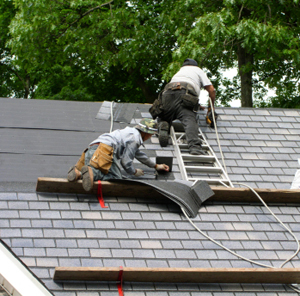How you go about repairing roof damaged by a storm  depends on its severity. For leaks, refer to the following procedure.
depends on its severity. For leaks, refer to the following procedure.
Fixing Roof Leaks
Required Tools and Materials
Drill (equipped with screwdriver bits)
Tape measure
Small brush
Roofing cement
Tin snips
Hammer
Chisel
Fluorescent chalk
Ladder
Replacement flashing
Garden hose
Step 1
Start by assessing the extent of the damage. Look at the flashing and determine where the problems are located.
Step 2
Use the drill to remove the defective flashing. If necessary, pry it loose with your chisel or hammer. Get the brush and remove any debris.
Step 3
Put some roofing cement on the sections below the flashing. Put the cement into any fissures or cracks you see. As you continue repairing roof damaged by a storm, don’t forget to expand the area you’re working on by three inches (all sides).
Step 4
Install the new flashing after ten minutes. Use the tin snips to make the flashing fit in. Use the drill to fasten the flashing in securely.
Step 5
Let the cement dry as indicated in the package instructions. When the cement has dried, spray the roof with water. Keep spraying for 5 minutes. Go inside and look for any leaks.
Fixing Damaged Roof Materials
Step 1
Go to the roof. Use the chalk to note the areas where there is heavy damage.
Step 2
Remove the damaged shingles, pebbles, branches or any other debris left on the roof by the rain. At this point you can commence repairing roof damaged by a storm.
Step 3
Apply the roofing cement around the affected area, beginning three inches from the affected area. Allow it to dry. Hose it for 10 minutes and check inside the house for leaks.
Assessing Hail Storm Roof Damage
Begin by examining the down spouts. What you are looking for are tile granuals. If there is plenty of it, chances are the hail has damaged the roof. You should also look at the gutters. If the hail was strong, the metal will bend. If this happens, you need to repair it.
Tips and Warnings
Before you go about repairing roof damaged by a storm, look at the ceiling first. There may be cracks there too. Other areas that should be inspected for damage are the fascia and the vents. When examining the roof, look for signs of lost shingle minerals.
Do not attempt to go up the roof if there are still strong winds or even some rain. You should also inspect the roof only if you can access it easily. Don’t try to get on the roof if the angle is too steep. Get someone to help you if the damage is extensive.
If you’re going to claim insurance, take photos of everything that was damaged. Do not move or disturb anything until you have the pictures. If the insurance company is going to send someone to assess the damage, leave the roof as it is.
There’s no question repairing roof damaged by a storm can be an arduous process. But if you know where and what to look for, fixing it will be less strenuous.


